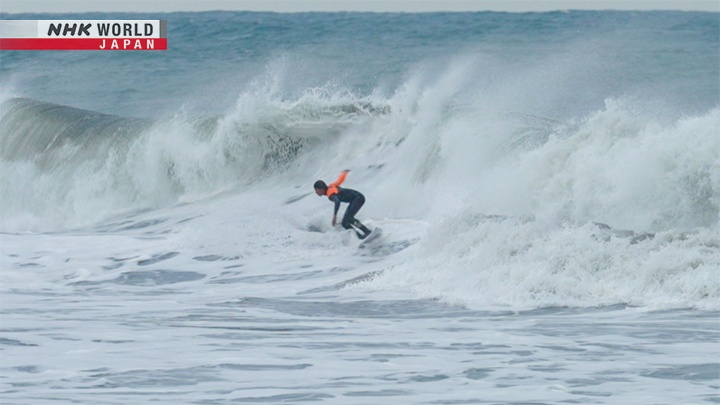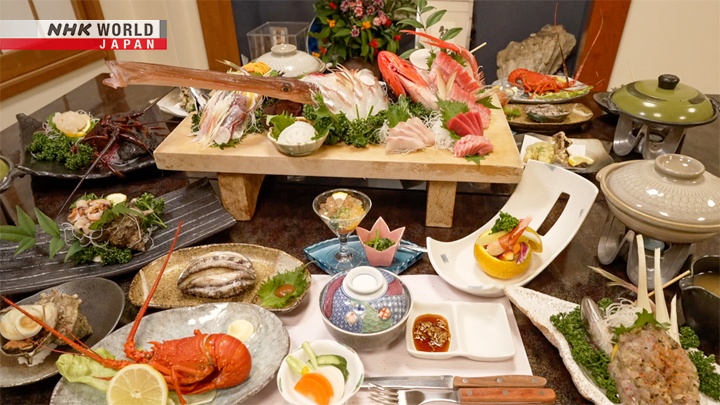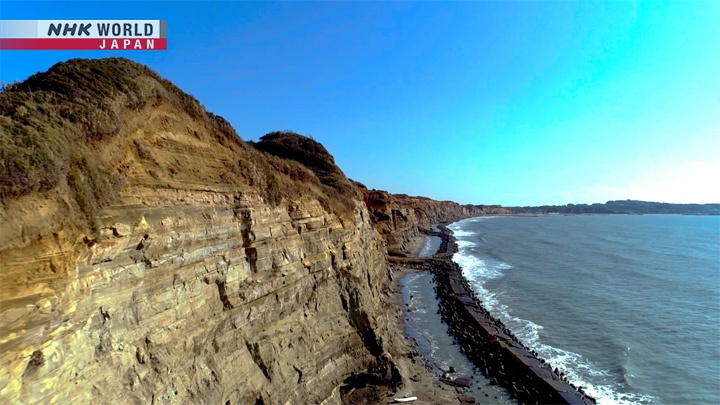Chiba's Peninsula: Facing the Pacific Ocean
Explore coastlines from a bird's-eye view! This time, the peninsula between Tokyo and the Pacific. We take a look at traditional food, crafts and sightseeing spots created by the rough seas.




Transcript
Touring Japan from the skies.
I'm your guide, Yumika!
Today we're visiting the pacific coast of Chiba's peninsula!
I'm Dominic, and I'm coming along for the ride!
I'm looking forward to getting off the beaten path!
Let's fly to some little-known locations and discover something new!
On Coastal Encounters, we take to the skies for a bird's eye view of Japan's coastlines!
Let's preview today's trip.
Chiba is right by Tokyo.
Nojimazaki, the southern tip of its peninsula, juts out into the Pacific Ocean.
We'll explore the coast, finding cool, little-known spots.
It's a 150-kilometer journey, ending at Inubosaki!
A Pacific coast trip! Sounds great.
Here's our start point.
Nojimazaki, the southernmost part of the peninsula.
I can see a white lighthouse.
That's Nojimazaki Lighthouse.
It was the second Western-style lighthouse in Japan,
first built about 150 years ago when Japan's modernization began.
Pretty old!
There are many reefs in this area, so it was built at the request of foreign countries for ships heading to Tokyo Bay.
The coastline does look pretty rugged.
This peninsula was formed by a hard, prehistoric layer of seabed gradually lifted up over time.
It was then eroded by the rough waves of the Pacific Ocean, which created this rocky coastline.
I had no idea there was such a wild area right by Tokyo.
There's also a current called the Kuroshio, which makes for mild ocean temperatures, even in winter.
The mild temperatures and the complex physical features of the sea lead to a rich variety of marine life.
Okay, here we are at the town of Chikura.
Is this a port?
There's some kind of rectangular thing jutting out into the water.
What is it?
It's a seafood facility.
Fishers catch fish and shellfish from the nearby sea, then keep them here until they're ready to be shipped.
People like wholesalers and restaurant owners can come to buy.
Can I go talk to them?
Sure!
Okay, see you in a bit!
Have fun!
Hello there.
Can I see what's in there?
Thanks!
Whoa, some nice-looking lobsters!
What kind are they?
These are Japanese spiny lobsters.
Here we call them Boshu-ebi. I'm going to buy them.
Then what?
Cook them for my customers.
I'm an innkeeper and chef.
He's here to buy ingredients to cook and serve at his inn.
They say there are many days when the ocean is too rough to go fishing.
That's why they stock seafood here like this.
- How about this 5 kilos here?
- Sure.
Whoa, what a unique shape.
What are these?
Turban shells.
Pretty big!
There are even bigger ones,
but this size is the most delicious.
When they've got these spikes, they look nice.
There are unusual rock formations with
kind of shelves where abalone attach.
There are abundant fishing grounds all over,
like those sand pits right over there.
Many kinds of fish and sea life to be caught.
Sounds like there's a lot of delicious seafood.
Yes, it's a great place for foodies.
Here's the seafood the innkeeper purchased.
To find out what he's going to make with them, I ask if I can visit his inn.
So this is the place. Very Japanese-looking.
Looks like a nice local inn and eatery that's very serious about its seafood!
Here's the kitchen.
Pardon me!
Oh, that's one of the turban shells he just bought.
He's cutting it while it's still raw.
Now he's putting it on top of the shell.
Turban shell sashimi. I wonder how it tastes.
Next, tuna sashimi.
He's cutting it with a knife that looks like a samurai sword!
The knife and the way you cut makes all the difference.
A dull knife can ruin the texture and flavor,
and make drippings come out.
Sashimi may seem simple, but it's quite deep.
This feast for two is complete. It looks like a brilliant work of art!
Sashimi isn't just sliced fish.
As he explained, things like cutting and serving style make all the difference!
This has made me want to learn even more about Japan's deep culinary culture.
There's actually a shrine near here said to be
the symbol of Japanese cuisine.
- I go about once a week. Want to take a look?
- May I?
- Sure. It's quite close.
- Great!
A shrine that symbolizes Japanese cuisine?
Can't wait to see what this is all about.
At the top of these stairs is the main part of the shrine, where you pray to the shrine's kami deity.
What kind of kami is it?
This is the sole shrine in Japan where a
kami of cooking resides.
Once upon a time, an emperor visited here.
He liked the chef who cooked for him so much
that he invited him to be the palace chef.
After that, he became the kami of cooking.
I see! A legendary chef who became a cooking kami!
Take a look at these wooden wish boards.
They all have cooking-related wishes on them.
Chefs from all over Japan come here to pray.
Someone who wants to become a top chef, a sushi chef wishing for good business,
even someone who wrote in English about opening a Japanese restaurant.
People aspiring to do great things with food really do come here from all over.
Thanks for your time today!
I can't wait to come back again and sample some cuisine.
This is the home of the cooking kami, after all!
Let's go further northeast along the Pacific coastline.
I see a city coming up.
It's called Kamogawa.
Looks like there's a boat coming in.
It was out in the ocean for fishing, no doubt.
This has long been a fishing town.
I wonder if they caught some fish to unload.
Oh, I can see some bright red fish in that box.
I bet that's kinmedai - splendid alfonsino.
This kind of fish is found deep underwater.
Guess they had to go out pretty far to catch it.
Living off the bounties of the Pacific, Kamogawa still has the culture of a traditional fishing town.
Let's go check it out.
Here we go!
What's that colorful strip there?
Does it have something to do with traditional culture?
Let me land and find out!
I see, it's a long strip of cloth.
Oh, hello.
Hello.
Sorry for dropping in.
What is this?
It's called maiwai-zome. A painted garment worn
by fishers to celebrate a big catch.
Maiwai-zome?
Yes. That's right.
I see.
Look at those eye-popping colors!
Are these made around here?
Yes.
- Are you an artisan?
- Yes.
Do you mind if I take a look?
Sure. We color them over in that workshop.
I'll show you.
I wonder what kind of clothes are made from that cloth.
Here's the workshop.
Oh, here it is.
So many colorful garments!
So these are worn to celebrate.
Such vivid colors. How do they color them like this?
Oh, here he goes.
This cloth must be 10 meters long.
The image is painted on little by little.
He carefully paints on one color at a time.
What is the paint made out of?
Pigments and a material called gojiru.
The pigments are made of natural minerals.
For example, the white is crushed seashells,
the brown is iron oxide rust, etc.
And what is gojiru?
It's made by soaking soybeans in water for a day,
then mashing and straining through a cloth.
Soymilk, basically!
He says the gojiru helps the pigment stick to the cloth.
Fascinating!
When did people start painting cloth like this?
They say maiwai-zome started around this
peninsula in the 19th century.
What characterizes the patterns?
They're originally for fishers, so they
often feature local fish.
Many feature sardines and saury,
local fish caught in large numbers here.
A deep relationship with the sea.
How about that bird?
It's a seagull. Places where you see seagulls
are often places with lots of fish. A good sign.
There was no radar back then,
so fishers followed the birds to find fish.
So they feature birds like seagulls and plovers.
Rough seas are never depicted.
That's because rough seas mean
you can't go out and fish.
I see!
This art shows the hopes and dreams of fishers who have long lived alongside the rough waves of the Pacific.
What an amazing piece of traditional culture.
And it's great to see a young person keeping it alive! Thank you!
We're halfway through our trip up the Pacific coast of Chiba's peninsula.
Pretty intense waves!
Check it out. This is where the rocky part of the coast ends.
Here it transitions into beaches.
Whoa, you're not kidding.
The beach goes on for a long stretch.
This is Kujukuri Beach, one of the longest beaches in Japan.
It stretches 66 kilometers. Only one beach in Japan is longer.
Huh, 66 kilometers?!
Wow, surfers even in winter.
Yeah, Kujukuri has a lot of great surfing spots.
You can always see some surfers having fun.
These guys have some skill! Looks amazing!
This section is called Tsurigasaki Beach.
It's known and loved by surfers around the world.
It was a competition site during the olympics in 2021.
Surfers in Japan consider it a must-visit location.
If it was chosen for Olympic-level competition, it must be good.
Cowabunga!
What's so special about these waves?
Let me go ask!
Ah, good timing.
Hi there.
- Hello.
- It's winter! Isn't it cold?
Yes, it is!
What's good about the waves here?
They're pretty fast, and break all at once,
and they're really great.
The speed is key.
Plus, a lot of themmove to the left.
Very high quality.
I like that kind a lot, so that's why I come here.
Can beginners like me have fun here?
The waves might be too fast for beginners.
I think newbies might want to gain some
experience before they try here.
This place is for the experts, huh.
No wonder it was chosen for the Olympics.
There's a shop near the beach where surfers hang out.
Let's go take a look.
Pardon me.
Whoa, lots of surfboards.
Hey, it's those surfers from the beach.
Hi again.
Hi.
Is this a surf shop?
Yes, it is.
I'm the owner. I build boards and run a brand,
working with other surfboard shapers.
You build surfboards?
Right. Some of my boards have
been entered in contests.
Can you show me some?
Sure. Right over here.
I made this one.
It's made for high performance,
for competition.
Are there a lot of competitive surfers around here?
Yeah. The Olympic venue is right nearby,
so competitive surfers from around Japan gather here.
They can practice here, and Narita Airport is close,
so they can go abroad to competitions.
Lots of people use it as a base.
The sand here is iron sand.
The sand is so hot in summer
you can't walk on it barefoot.
The sand bunches together, so it's harder
than other beaches.
Because it's hard, the waves break like on a reef,
so they're nice and big.
I think I get it.
The waves are nice and big, so this is the perfect place for seasoned surfers.
The girl I just met at the beach, by the way, is a high school freshman,
but she's a ranked pro surfer in Japan!
Her brother next to her is a middle schooler aiming for the pros.
Best of luck to both of them!
Looks like they're back at it.
I bet it won't be long before they go from this beach to the Olympics!
The long, long Kujukuri Beach is coming to an end.
Next, onto a spot called Byobugaura!
Whoa, what's this? Incredible cliffs!
These cliffs were formed when the old land of the peninsula was eroded by the waves of the Pacific.
They're 40 to 50 meters tall and stretch for about 10 kilometers.
They say the sand eroded from these cliffs became the beaches of Kujukuri!
Now that's history on an epic scale.
Moving past the Byobugaura cliffs, we can see a cape jutting into the ocean.
The protruding tip to the east is called Inubosaki.
It's our final destination.
We've traveled 150 kilometers from the south end of the peninsula!
Here's the Inubosaki Lighthouse.
It was built about 150 years ago.
It's been lighting up these stormy seas for decades.
The view of the Pacific from the lighthouse must be magnificent.
Sightseers are allowed in, actually!
I want to go!
Let's land and check it out together.
So you go up a spiral staircase. Cool.
There are 99 steps. Do your best!
Whew! It's getting steeper! Just a bit more!
We made it! We made it!
What a view!
This ocean leads all the way to the Americas!
Today, we saw places, people and culture shaped by the rough waves of the coastline.
How'd you like it?
Well, we saw a lot of what makes Japan so interesting. It was great!
I can't wait for our next coastal encounter!
See you soon!